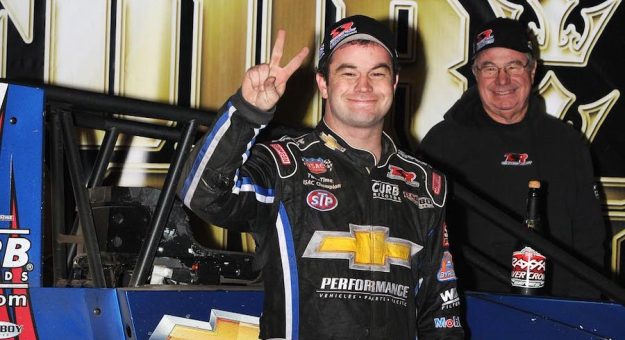INDIANAPOLIS — One day, in a few years, he was going to be the most interesting 40-year-old ex-driver a columnist could hope to talk with. That was my thought, anyway.
I couldn’t think of another winning racer who grew up surrounded by so much excellence, who’d been an eyewitness to so much history, who’d listened in on so many key conversations.
Exhibit A: Sept. 4, 1996, Terre Haute, Ind.
Bobby East, age 11, was standing in an enclosed trailer belonging to Steve Lewis, the era’s dominant midget owner.
The Lewis team was managed by the boy’s father, legendary car builder Bob East. Its two drivers, Tony Stewart and Kenny Irwin, were stacking tear-offs on their helmet visors. The longest race on the USAC calendar, the Hut Hundred, was mere minutes away.
Both drivers were on their way to big things. Stewart had led the Indy 500 as a rookie; Irwin had taken his first tentative steps in the NASCAR Camping World Truck Series. But on this late-summer night at the Terre Haute Action Track, what mattered most to each of them was beating the other guy.
Stewart, practiced at the art of poking a rival, stage-whispered to the kid, “Does Kenny know what it pays to finish second?” Irwin, practiced at the art of ignoring trash talk, stayed focused on those tear-offs.
Bobby East was the only witness.
He had seen Stan Fox win with midgets his dad prepared and he’d watched Stevie Reeves drive the Lewis car to a pair of USAC championships. Now, he was entering the most impressionable years in every boy’s life, when the things he sees and hears will stay with him forever.
I always wondered what he took from that moment at Terre Haute.
My guess is he noted Stewart’s matchless self-confidence, and Irwin’s quiet, unshakable determination. But I can’t say for sure; this year, last year and the year before that would have been too soon to ask him about such things.
See, Bobby East became a race driver himself, and a good one.
He parlayed the 2004 USAC midget title into a Ford-backed shot at NASCAR. Between 2005 and ’08, he ran 11 races on the Xfinity tour and 31 in the Truck Series. His timing couldn’t have been worse. When the U.S. economy veered off a cliff in 2007, it crashed the young-driver programs of every top-tier NASCAR team.
He went back to USAC and earned back-to-back Silver Crown championships with Stewart’s team in 2012-’13.
By then, his USAC national stats sparkled: 11 Silver Crown victories, 15 in sprint cars, 22 in midgets.
In 2014, he finished eight of his 10 Silver Crown starts in the top five. But at year’s end, something — maybe the lingering effects of past concussions — told him that enough was enough. At 29, he had driven his last race.
No one walks casually away from something he loves. There is always heartache attached. This was another interesting layer to an interesting young man’s interesting story. I wanted to hear it all, but there was no need to pick at a fresh wound.
Wait, wait, I told myself, and one day ask Bobby East how his extraordinary access contributed to his success. He spent years in the company of champions, on his way to being one. What rubbed off on him?
Think about all of those Lewis/East drivers.
Jason Leffler had a swagger and a bring-’em-on attitude. J.J. Yeley and Dave Steele were chassis savants staring at their cars, their minds swirling with spring rates and tire-stagger options. Dave Darland tamed every dirt-track cushion on the USAC trail. Kasey Kahne had the face of an altar boy and the icy nerve of a fighter pilot.
When any of those guys walked into the Lewis trailer after a feature, Bobby was there, on good nights and bad. He was a few feet away every time his father, that period’s wisest short-track guru, reran the race with his drivers.
I imagined Bobby asking his dad to rerun it again on their ride home.
As a teenager, he talked as if being a race driver was a foregone conclusion. It was obvious that as long as he had the raw speed and the requisite hand-eye-posterior communication, he’d be a winner. He had already absorbed everything a great driver should and shouldn’t do. He knew how to race.
Did he think he’d get a chance at victory in the three biggest outdoor midget races — the Hut Hundred, the Belleville Nationals and the Turkey Night Grand Prix? Probably. But did he ever believe that he might win all three in the same season, as he did in 2004?
One day, a few years from now, I would ask him about all those people, all those dreams, all the things he was able to do. But I would wait until I thought he was at peace with the things he wasn’t able to do. It was still too soon.
And now it is too late.
Bobby East died in a senseless July stabbing at a California gas station. He was 37. He left a family that loved him — father Bob, mother Janice, sisters Amy and Alison — and their loss is immeasurable.
Our loss, racing’s loss, is that he took with him the stories that only he could tell.
